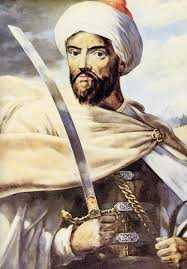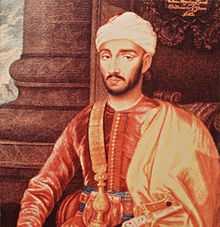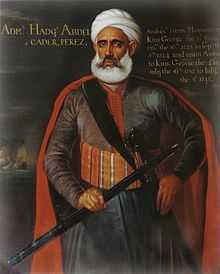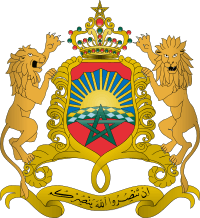Ismail Ibn Sharif
| Moulay Ismaïl Ibn Sharif | |
|---|---|
 Portrait of Ismail Ibn Sharif | |
| King of Morocco | |
| Reign | 1672–1727 |
| Coronation | 1672 |
| Predecessor | Al-Rashid |
| Spouse |
1) Lalla Khnta 2) Lalla Aisha Mubarka 3) Lalla Umm al-Iz at-Taba [Umelez Ettaba] (d. after 1721) 4) Lalla Bilqis 5) Khnata bent Bakkar 6) Lalla Halima as-Sufianiya [Hazezas] 7) a lady from the al-Taligiyya clan 8) Lalla Alwa 9) Mrs. Shaw, an Irishwoman [1] |
| Born |
1634 Rissani, Emirate of Tafilalt |
| Died |
22 March 1727 Meknes, Morocco |
Moulay Ismaïl Ibn Sharif (1634? or 1645? – 22 March 1727), reigned 1672–1727.[2] (Arabic: مولاي إسماعيل بن الشريف ابن النصر) was the second ruler of the Moroccan Alaouite dynasty. He is also known in his native country as the "Warrior King".
Rule
He ruled from 1672 to 1727 succeeding his half-brother Moulay Al-Rashid who died after a fall from his horse. At the age of twenty-six, Moulay Ismaïl inherited a country weakened by internal tribal wars and royal successions. Meknes, the capital city he built, is sometimes called the "Versailles of Morocco", because of its extravagance. Some of the stones were plundered from the ancient Roman ruins at Volubilis.[3]
He has also been given the epithet "The bloodthirsty"[4] for his legendary cruelty. In order to intimidate rivals, Ismail ordered that his city walls be adorned with 10,000 heads of slain enemies. Legends of the ease in which Ismail could behead or torture laborers or servants he thought to be lazy are numerous. During the half century of Ismail's rule, it is estimated 30,000 people died.[5]

During Moulay Ismaïl's reign, Morocco's capital city was moved from Fez to Meknes. Like his contemporary, King Louis XIV of France, Moulay Ismail began construction of an elaborate imperial palace and other monuments.
In 1682 he sent Mohammed Tenim as an ambassador to Louis XIV, and he even made an offer of marriage to Louis XIV's beautiful "legitimised" daughter Marie Anne de Bourbon. Marie Anne refused.
Legacy

Moulay Ismaïl is noted as one of the greatest figures in Moroccan history. He fought the Ottoman Turks in 1679, 1682 and 1695/96. After these battles Moroccan independence was respected. Another problem was the European occupation of several seaports: in 1681 he retook al-Mamurah (La Mamora) from the Spanish, in 1684 Tangier from the English, and in 1689 Larache also from the Spanish. Moulay Ismaïl had excellent relations with Louis XIV of France, the enemy of Spain, to whom he sent ambassador Mohammad Temim in 1682. There was cooperation in several fields. French officers trained the Moroccan army and advised the Moroccans in the building of public works.

Moulay Ismaïl is also known as a fearsome ruler and used at least 25,000 slaves for the construction of his capital.[7] His Christian slaves were often used as bargaining counters with the European powers, selling them back their captured subjects for inflated sums or for rich gifts. Most of his slaves were obtained by Barbary pirates in raids on Western Europe.[8] Over 150,000 men from sub-Saharan Africa served in his elite Black Guard.[9] By the time of Ismail's death, the guard had grown tenfold, the largest in Moroccan history.

Moulay Ismaïl is alleged to have fathered a total of 867 children, including 525 sons and 342 daughters, was noted by 1703 and his 700th son was born in 1721.[4]This is widely considered the record number of offspring for any man throughout history that can be verified.
After Moulay Ismaïl's death at the age of eighty (or around ninety by the 1634 birthdate) in 1727, there was another succession battle between his surviving sons. His successors continued with his building program, but in 1755 the huge palace compound at Meknes was severely damaged by an earthquake. By 1757 his grandson, Mohammad III moved the capital to Marrakech.
In popular culture
Ismail Ibn Sharif is mentioned in chapter 11 of Voltaire's Candide. The character of the sultan in the novel "The Sultan's Wife" by Jane Johnson is based on Moulay Ismaïl. In Marguerite Henry's King of the Wind "Sultan Mulai Ismael, Emperor of all Morocco" sends six Arabian horses to Louis XV, "the boy King of France."[10]
See also
- Khnata bent Bakkar
- Alaouite
- History of North Africa
- History of Morocco
- Anglo-Moroccan alliance
- List of people with the most children
Notes
Part of a series on the |
|---|
| History of Morocco |
 |
|
|
|
Related topics
|
| Morocco portal |
- ↑ "MOROCCO3".
- ↑ Abun-Nasr, J.M., A History of the Maghrib in the Islamic Period, page 230. Cambridge University Press, 1987
- ↑ C.Michael Hogan, Volubilis, Megalithic Portal, ed. A. Burnham (2007)
- ↑ 4.0 4.1 "Some magical Moroccan records". Guinness World Records. Guinness World Records Limited. March 3, 2008. Retrieved March 20, 2010.
- ↑ Lawrence, Paul R. (2010). Driven to Lead: Good, Bad, and Misguided Leadership. John Wiley and Sons. ISBN 0-470-62384-5.
- ↑ In the lands of the Christians by Nabil Matar, back cover ISBN 0-415-93228-9
- ↑ Milton, Giles (2004). White Gold : the Extraordinary Story of Thomas Pellow and North Africa's One Million European Slaves. Hodder. p. 352. ISBN 0-340-79469-0.
- ↑ "Tragic Inventory".
- ↑ "...A la fin du règne de Moulay Ismaïl, qui resta au pouvoir pendant 57 ans, la garde noire comptait 150000 combattants...", p39 of "Des Tranchés de Verdun à l'église Saint Bernard" by Bakari Kamian edition KARTHALA
- ↑ Henry, Marguerite (2006). King of the Wind: The Story of the Godolphin Arabian. Aladdin: Reissue edition. pp. 48, 50. ISBN 1416927867.
References
- Abum-Nasr, Jamil M. (1987). A History of the Maghrib in the Islamic Period.
- Pennell, C.R. (2000). Morocco Since 1830.
- Bakari Kamian. (2001). Des Tranchés de Verdun à l'église Saint Bernard.
External links
| Wikimedia Commons has media related to Moulay Ismail. |
- (Arabic) Muslim rulers at hukam.net
- (Arabic) Evolution is over
| Preceded by Al-Rashid |
Sultan of Morocco 1672–1727 |
Succeeded by Ahmad |
|